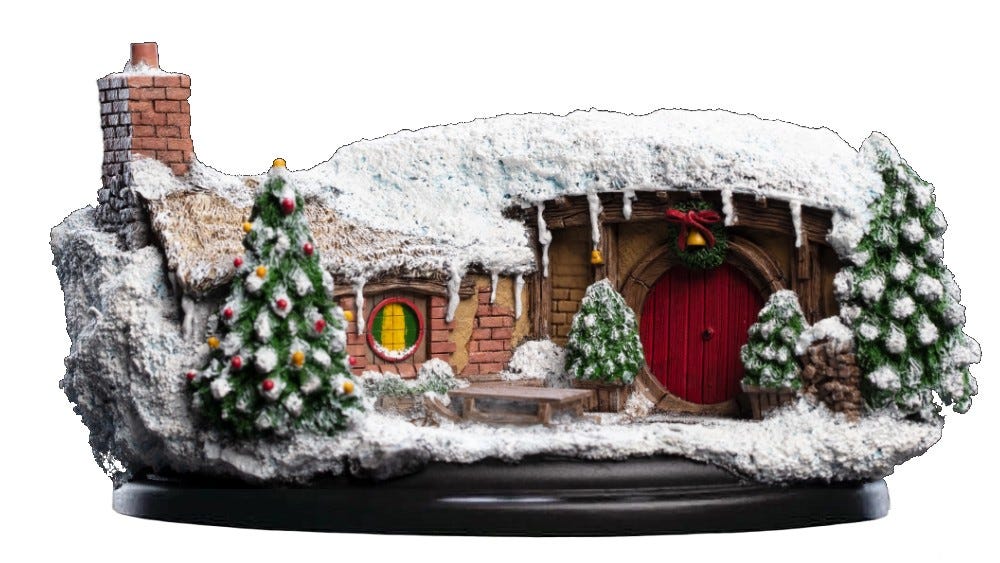The Hidden Connection Between Christmas, Fairy-stories, and 'The Lord of the Rings"

Hello friends and Merry Christmas! I hope that the holiday is full of “food and cheer and song,” as well as time with loved ones, rest, and whatever else you associate with and look forward to the holidays for.
Today I have a short reflection on Christmas and what Tolkien termed '“fairy-stories” for you.
Quick note: now through the end of 2024, all paid subscriptions to Jokien with Tolkien are 20% off! In addition, I’m trying something new out: I’m giving the next 10 subscribers who join at the ‘founding’ level lifetime access to Jokien with Tolkien Extended Edition! (Pay for one year and I’ll comp you forever) For details, hit the button below:
The Hidden Connection Between Christmas, Fairy-stories, and 'The Lord of the Rings”
In the Epilogue to his classic essay “On Fairy-Stories,” Tolkien applies his concept of ‘eucatastrophe’ to Christmas:
“The birth of Christ is the eucatastrophe of Man’s history” (“On Fairy-Stories,” The Tolkien Reader, 88–89).
By ‘eucatastrophe’ Tolkien means
“the consolation of fairy-stories, the joy of the happy ending: or more correctly of the good catastrophe, the sudden joyous ‘turn’ (for there is no true end to any fairy-tale)” (86)
In the birth of Christ, all of human history has “turned.” Where there was no hope, Hope has appeared. Into strife and war, Peace has come. Amidst sorrow and grief, Joy himself is revealed. A sudden, joyous happy ending begins on December 25th that will find its conclusion on Easter.
It is not explicit in the text, but there is a connection to Christmas in The Lord of the Rings that functions as the start of a similar journey to Easter.
In Appendix B of The Lord of the Rings, we learn that the Company leaves Rivendell on December 25th, beginning their mission to destroy the Ring on the same day we celebrate Christmas.
This is one of my “10 Reasons The Lord of the Rings is a Christmas Movie”—read the rest here:
Not only that: the eventual destruction of the One Ring in the fires of Mount Doom occurs on on March 25th. What’s the significance of March 25th? It is one of the traditional dates for the Crucifixion in antiquity.
Just like the life of Christ began on Christmas and he journeyed from the cradle to the cross, the quest of the Ringbearer from Rivendell to Mount Doom began on December 25th and concluded on a date traditionally associated with Easter.
Christmas and Easter are inexorably linked: the beginning and the ending of Christ’s life and mission are the high points of salvation history, marking the defeat of the power of sin and death and Satan. So it is fitting that they function as the beginning and the ending of the Quest to destroy the Ring, marking the defeat of the power of Sauron.
“The Birth of Christ is the eucatastrophe of Man’s history. The Resurrection is the eucatastrophe of the story of the Incarnation. This story begins and ends in joy…There is no tale ever told that men would rather find was true…”
— Tolkien, “On Fairy-stories”
Where there once was only dismay, there is now Joy. What seemed like it could only end in catastrophe has now ended in a good catastrophe, a eucatastrophe.
“Joy to the world” indeed! Joy, joy from beyond the walls of the world, is breaking in. And it all began in a humble manger.
Merry Christmas, friends!
For more on how Easter is the eucatastrophe of the Incarnation, here’s an essay where I unpack that:
That’s all for today’s newsletter. Farewell, friends, and have a wonderful rest of the week! Merry Christmas!
Reminder that this final week of the year you can upgrade to the Extended Edition of Jokien with Tolkien for 20% off and that I’ve opened up 10 spots for lifetime access! These offers expire 1/31. For more details, check out the subscription button below:
📚 You can read more of my writing by reading my books! My latest is a collection of essays on The Lord of the Rings, The Silmarillion, and more of Tolkien’s works (and their adaptations). You can also find it and more of my books on Amazon or Gumroad
⚔️ If someone forwarded this email to you or you found it through social media or Google, I’d like to invite you to join 11,000+ subscribers in the Jokien with Tolkien community: Subscribe here and get a free gift just for joining!
🏹 Chosen as a Substack Featured Publication in 2023
🪓 Official merch available in the Jokien with Tolkien store
❌ All typos are precisely as intended
🔗 Links may be affiliate, which is a free-to-you way to support this newsletter where I earn a small commission on items you purchase
🗃️ Can’t wait till next week for more content? View the archive
🎯 Interested in writing a guest piece? Check out my submission guidelines. Want to sponsor a future issue of Jokien with Tolkien? E-mail me at jrrjokien@jrrjokien.com






My son and I are about to embark on our own little private book club, starting with The Hobbit and ending with The Silmarillion. I'm forwarding this post to him because I think he would be interested in subscribing. Thank you for opening up the "hidden" things here. So intriguing!
This is probably the most subtle way Tolkien could have referenced his Catholic faith to those in the know. It stands in contrast to the more blatant usage of the Christ motif that C.S. Lewis employed in the Narnia series...